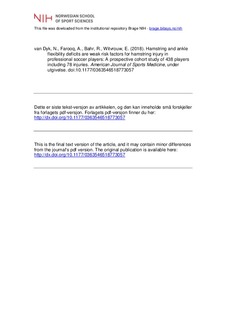| dc.contributor.author | van Dyk, Nicol | |
| dc.contributor.author | Farooq, Abdulaziz | |
| dc.contributor.author | Bahr, Roald | |
| dc.contributor.author | Witvrouw, Erik | |
| dc.date.accessioned | 2018-09-05T08:57:20Z | |
| dc.date.available | 2018-09-05T08:57:20Z | |
| dc.date.created | 2018-05-22T08:59:56Z | |
| dc.date.issued | 2018 | |
| dc.identifier.citation | American Journal of Sports Medicine. 2018, 46, 2203–2210. | nb_NO |
| dc.identifier.issn | 0363-5465 | |
| dc.identifier.uri | http://hdl.handle.net/11250/2560853 | |
| dc.description | I Brage finner du siste tekst-versjon av artikkelen, og den kan inneholde ubetydelige forskjeller fra forlagets pdf-versjon. Forlagets pdf-versjon finner du på sage.com / In Brage you'll find the final text version of the article, and it may contain insignificant differences from the journal's pdf version. The definitive version is available at sage.com | nb_NO |
| dc.description.abstract | Background: Hamstring injuries remain a significant injury burden in sports such as soccer that involve high-speed running. It has repeatedly been identified as the most common noncontact injury in elite male soccer, representing 12% of all injuries. As the incidence of hamstring injuries remains high, investigations are aimed at better understanding how to prevent hamstring injuries. Stretching to improve flexibility is commonly used in elite-level sports, but risk factor studies have reported contradicting results, leading to unclear conclusions regarding flexibility as a risk factor for hamstring injuries. Purpose: To investigate the association of lower limb flexibility with the risk of hamstring injuries in professional soccer players. Study Design: Cohort study; Level of evidence, 2. Methods: All teams (n = 18) eligible to compete in the premier soccer league in Qatar (Qatar Stars League [QSL]) underwent a comprehensive musculoskeletal assessment during their annual periodic health evaluation at Aspetar Orthopaedic and Sports Medicine Hospital in Doha, Qatar. Variables included passive knee extension and ankle dorsiflexion range of motion. A clustered multivariate Cox regression analysis was used to identify associations with the risk of hamstring injuries. Receiver operating characteristic (ROC) curves were calculated to determine sensitivity and specificity. Results: A total of 438 unique players (72.4% of all QSL players) competed for 601 player-seasons (148 players competed both seasons) and sustained 78 hamstring injuries. Passive knee extension range of motion (hazard ratio [HR], 0.97 [95% CI, 0.95-0.99]; P = .008) and ankle dorsiflexion range of motion (HR, 0.93 [95% CI, 0.88-0.99]; P = .02) were independently associated with the injury risk. The absolute differences between the injured and uninjured players were 1.8° and 1.4 cm, respectively, with small effect sizes (d < 0.2). The ROC curve analyses showed an area under the curve of 0.52 for passive knee extension and 0.61 for ankle dorsiflexion, indicating failed to poor combined sensitivity and specificity of the 2 strength variables identified in the multivariate Cox regression analysis. Conclusion: This study identified deficits in passive hamstring and ankle dorsiflexion range of motion as weak risk factors for a hamstring injury. These findings have little clinical value in predicting the risk of future hamstring injuries, and test results must therefore be interpreted cautiously in athletic screening. | nb_NO |
| dc.language.iso | eng | nb_NO |
| dc.subject | hamstring | nb_NO |
| dc.subject | muscle injury | nb_NO |
| dc.subject | flexibility | nb_NO |
| dc.subject | injury prevention | nb_NO |
| dc.title | Hamstring and ankle flexibility deficits are weak risk factors for hamstring injury in professional soccer players: A prospective cohort study of 438 players including 78 injuries | nb_NO |
| dc.type | Journal article | nb_NO |
| dc.type | Peer reviewed | nb_NO |
| dc.description.version | acceptedVersion | nb_NO |
| dc.source.pagenumber | 8 | nb_NO |
| dc.source.journal | American Journal of Sports Medicine | nb_NO |
| dc.identifier.doi | 10.1177/0363546518773057 | |
| dc.identifier.cristin | 1585799 | |
| dc.description.localcode | Seksjon for idrettsmedisinske fag / Department of Sport Medicine | nb_NO |
| cristin.unitcode | 150,34,0,0 | |
| cristin.unitname | Seksjon for idrettsmedisinske fag | |
| cristin.ispublished | true | |
| cristin.fulltext | postprint | |
| cristin.qualitycode | 2 | |
